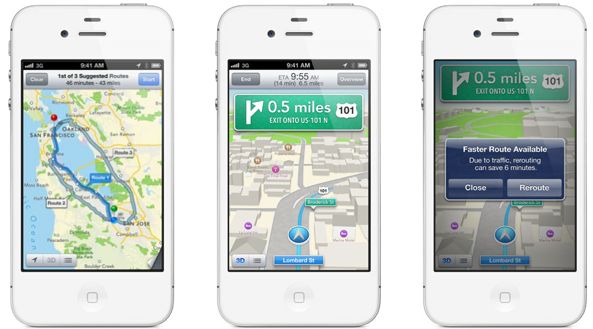Consumer Reports, an influential U.S. magazine published monthly since 1936 by Consumers Union, gave Apple’s iPhone 5 a thumbs-up recently but initially slammed iOS 6 Maps navigation (“we were disappointed”). Melted bridges aside, the publication known for its reviews and comparisons of popular products took both Apple Maps and Google Maps for a spin, concluding that Apple’s offering is “certainly more favorable than comments and articles that we’ve been reading online”…
The publication compared turn-by-turn navigation in iOS 6 Maps running on an iPhone 5 to a Samsung Galaxy S3 running Android 4.0.4 Ice Cream Sandwich with Google Maps, each on a different carrier.
Evaluations were conducted in the greater New York City area, find findings published in a blog post last Friday.
Overall, Apple’s mapping solution did impress Consumer Reports with its visual flair, signage, and points of interest info. Google Maps provide for greater customization, but are more “business like” and “less fun”.
Consumer Reports found that both Apple Maps and Google Maps “route effectively, providing clear guidance and great points-of-interest integration”.
As for the criticism of Apple’s partnership with TomTom, a leading navigation company:
We suspect many criticisms pointing to the map quality are misguided, as we have found TomTom to provide quality maps and guidance across multiple platforms. Instead, the fault may be Apple’s software applied to the TomTom data.
Other notables:
- voice recognition seemed comparable between the platforms
- both phones will accept calls while navigating and both return to navigation automatically when a call ends, but Google Maps are more customizable: you can set the volume for voice directions while talking on the phone
- 3D view is a novelty feature rather than a component of navigation
- both platforms have comparable information about restaurants and other attractions (Apple’s using Yelp and Google partners with Zagat)
- each app provides contact information, reviews and user-submitted photos
Apple Maps have some issues with the search algorithm resulting in a map inaccuracy:
The system couldn’t identify the location by “train,” instead requiring a search for “Metro North”- a name that a visitor to the region may not be familiar with.
Summing up, Consumer Reports concludes:
Both the free Apple and Google navigation apps provide clear routing directions. Apple feels like a less-mature product.
It certainly does, but let’s revisit this claim in a few years.
When getting down to the nitty gritty, Google provides a better overall package, but we feel that both provide a good solution for standard software.
So, it seems that both platforms provide decent stock navigation capabilities, with Google having an edge in this respect due to its location and navigation expertise and especially given the company’s been doing this for seven years now.
As a result, Google has more accurate crowd-sourced intelligence and can put its data sets to better use.
On a final note, Onavo found that iOS 6 Maps are seven times more bandwidth-efficient compared to Google because Apple is using vectors whereas Google still relies on bitmap tiles. The difference becomes evident when searching for locations and zooming in and out to specific locations.
On Google Maps, the average data loaded from the cellular network for each step was 1.3MB. Apple Maps came in at 271KB – that’s approximately 80% less data! On some actions, such as zooming in to see a particular intersection, Apple Maps’ efficiency advantage edged close to 7X.
That’s another thing to consider in today’s world of metered cellular data.
Another thing to keep in mind: Apple’s fantastic called Flyover is a major data hog due to complex 3D data. Trust me, you don’t want to invoke Flyover mode unless on WiFi.
Onavo also has a free iOS app which promises to triple the data plan you’re on by routing email messages, apps or web sites through its cloud-based servers that compress data to as much as 90 percent.
Do you agree with Consumer Reports’ assessment?
